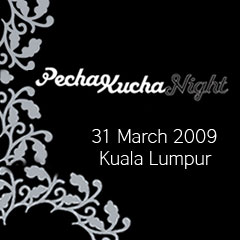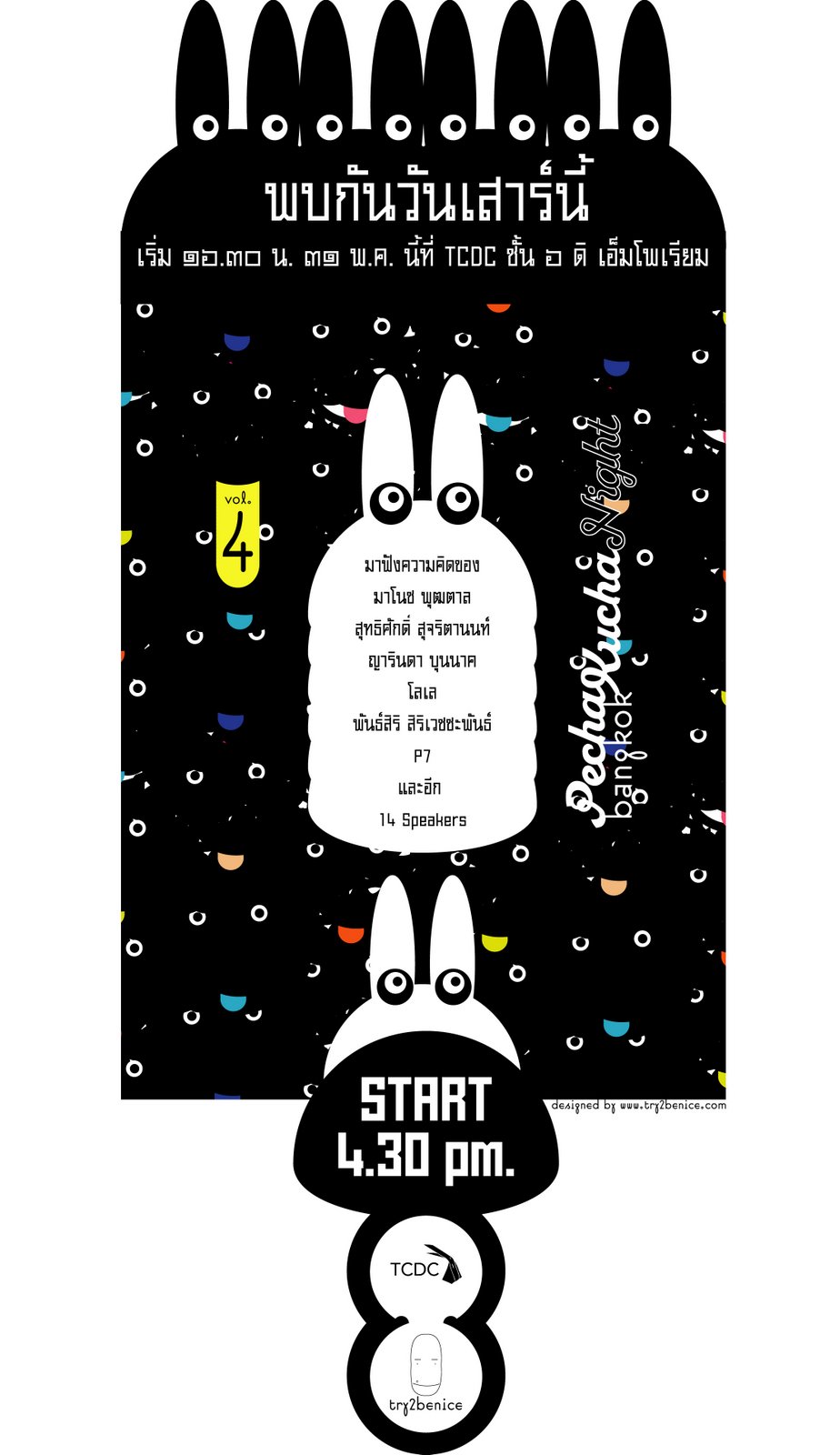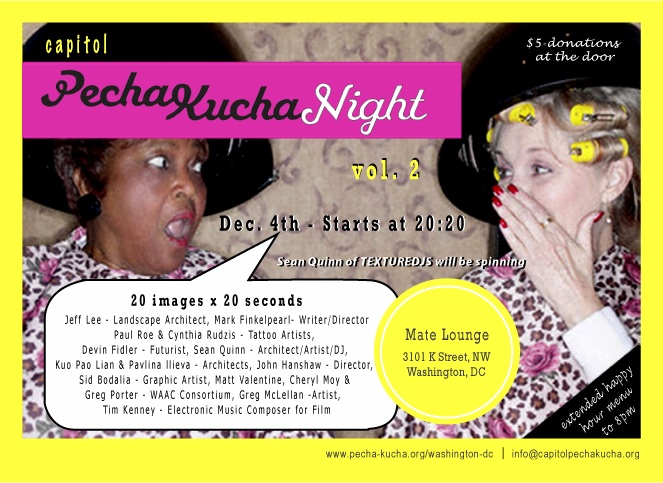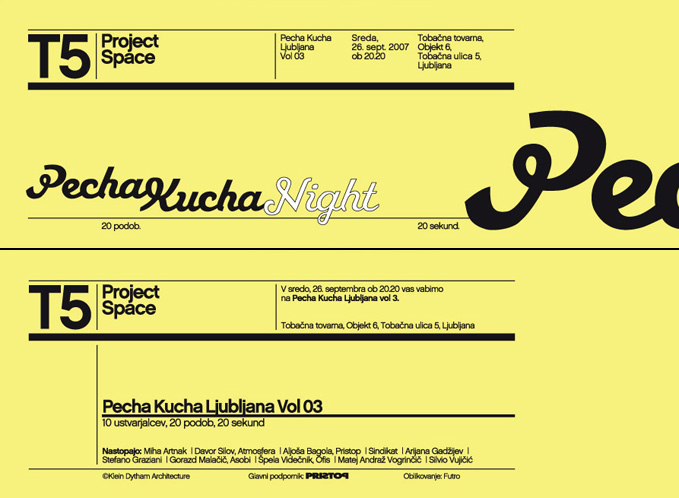

Pecha Kucha Night Vol. 6 last Tuesday (31 Mar 09) was great. The fun vibe and enthusiastic crowd were especially welcome coming straight from the relative sombreness of Galeri Petronas’ Art Appreciation Series. Of course, the two events are not to be compared, since Pecha Kucha was held at cute new hotspot Urbanattic, and featured two words so dear to people’s hearts: free beer.
Pecha Kucha was introduced in 2003 by Astrid Klein and Mark Dytham of Klein-Dytham Architecture. It’s a presentation format requiring speakers to stick to 20 slides, each shown for only 20 seconds. I call it an act of genius. Gone are the long, ponderous talks while audiences squirm and sigh in their auditorium seats, wondering what they’ll have for dinner. Pecha Kucha events are now held in over 180 cities world wide, and Vol. 6 of Pecha Kucha KL, organized by The British Council, didn’t dissapoint. The air was buzzing with happy creativity.

That night, I observed a few differences between the design and art worlds. Designers seem to speak of their work with alot more confidence and energy. I speculate that this comes from a sense of validation, from knowledge that their creativity has distinct market value. The design world is business oriented, which breeds healthy competition that exists as a result of larger audiences, markets and industries. Staying informed and connected with what others are doing is more than good business sense, it’s essential for surival. This encourages information sharing and the forming of strategic networks. Stop me if I’m sounding like an evangelist, because I’m not championing anything here, just stating what seems to be obvious.
In comparison, the art world is like a runty little brother/sister, fond of staying in our own room in the attic. We’re creating amazing stuff in there, but its not getting seen by enough people. I think designers freely acknowledge the pink elephant in the business of creativity: money. I don’t buy into the view that art is somehow ‘purer’ because it has a smaller audience/market – we’re selling what and when we can just the same, only to less people! I don’t advocate following the design model of creativity, but we can only benefit from observing how others do it, and how they manage to thrive in the process. We can take what’s useful and apply it to our own practices. Pecha Kucha is certainly a case in point: the speakers included a metalsmithing studio, documentary filmmaker, start-up business initiative and lighting designer! The audience was big, diverse and super-on.
The art world has more than enough creativity bursting at the seams, we just need to let it do its thing: burst out.
(SC)
~
Pecha Kucha Vol. 6 was held on Tuesday, 31 March 2009 @ Urbanattic, Capsquare
Look out for the photo gallery in an upcoming post.
Pecha Kucha flyers from around the world:

~
 ~
~

~

~

~

Sorry, the comment form is closed at this time.
What about this, a designer has to appear to be, or am in truth really confident in convincig a client of the work – that’s solemn; whereas more often then not, an artist while talking about one’s work would deliberate into many aspects and gets distracted, and even at times confessing one’s uncetainty, doubt and struggles – now that’s very serious about the pursuit as an artist.
Very often we would rather consume someone else’s creative certainty rather then giving ourselves too much room for imagination in figuring out an artist’s conflicting struggles.
And yes, able to sell or selling well breeds confidence, is indeed a measure of a successful mentality in our modern world – those educated and economically successful ones would always be more confident in projecting thmesleves and thier worldview.
If indeed the Malaysian art market is a very small pie, it would have many artists with inner selfdoubts and lacking confidence. Or mabye artist in Malaysia just lack presentation and good communication skill, or worst still are not able to deliver or engage in intellectual and smart conversation, is that true?
Hi James – all really good points.
Chicken or egg – Malaysian art market is small = lack of confidence in artists = small Malaysian art market = lack of confi…
It seems to me that the only way out of the cycle is for artists to do something about it. Otherwise we’ll be waiting for the cows to come home/for our audience to ‘change’ and become suddenly more generous and aware.
or worst still are not able to deliver or engage in intellectual and smart conversation, is that true?
I don’t know. This is the question I’m asking now… if it’s true then it’s really scary. But at least we should admit it and try to move forward.
… or worse still are not able to deliver or engage in intellectual and smart conversation, is that true?
i believe this to be true. but it also has to do with what we demand from contemporary artist these days that has resulted in the lack being problematic. artists of course are now expected to belong to a caste of public intellectuals, no longer the maker of visually pleasing works.
but this might change soon, according to some analysis. Soon, we can all pretend to be schizophrenic and video it on youtube and it will be counted as art. no need intellectual engagement really.
sooo many expectations.
artist dont need to ‘pretend’ to be schizophrenic. They are schizophrenic. and ‘you’ made them so.
‘you’ refers to?
– modern and contemporary artists who have continued to push the boundaries of what it means to be an artist?
– academics, critics, curators, who have supported the careers of these artists and write them into history?
– audience who want more than just looking at a pretty picture?
There is only a very small group of people who is primarily concerned with making visually pleasing works, expat housewives and English landscape watercolourists. A caveman artist or Raphael would not have visual pleasure as their primary concern, their theoretical interest underpins just as much in their art too. Isn’t all great art more than what is beautiful?
Yes exactly johann.
Artist make art that’s their job. How you define ‘art’ well, that’s another story with no beginning and no end.
I like this post as it alludes to question what the prerequisites for the job function of the ‘artist’ are. This is very relevant and a very large dilemma for many artists, myself included. The artist has joined (been forced to join) ‘slash’ culture… and I’m not denying it. This has / is happening but there is a cost as well.
Its not good enough now to just be good at drawing or whatever with an idea behind it.
An artist to get any recognition and be recognised as ‘an artist’ must be skilled in their chosen media / able to speak publicly in an engaging and intelligent manner / be able to write articulately / must have management / marketing / PR skills / pitch ideas to respective interested parties / be attractive enough to do celebrity fashion shoots / must have an intimate knowledge of art history & art movements / must be able to position themselves within the continuing debate of their own & global art developments / must be purveyors of meaning / be public intellectuals etc etc etc
Meanwhile they also have to be sensitive, well read, contemporary in their ideas enough not to be called a hobbyist. They also must find the time to actually make some work.
And their bill must not be too high so as not to be thought of us unethical or pandering only to the elite.
Hell, I would like to be an artist like that but then i wouldnt need curators and writers to ‘help’ me with their charity and generosity for writing me into history.
The expectations on artists worry me because most i know fall short. Not because they dont make great work but because they are ‘just’ artists.
Academics, critics, curators, writers, gallerists, institutions, audiences get on with YOUR job. Not to help out that poor artist who’s struggling to be all of the above but for our cultural landscape as a whole.
sorry arteri feel like i should go back to lurking but you want people to vent right?
Just read back what i wrote. All i really wanna say is artists speak best through their work. Sometimes they’re crap public speakers or simply dont articulate themselves well verbally or in written word. Sometimes language is an issue. Sometimes they dont even want to turn up to their own openings. But i dont think they should be penalised for this or that this means they’re lesser as artists.
Also i resent the tone Johann that “- academics, critics, curators, who have supported the careers of these artists and write them into history?”
It’s not about the artists. Curators, critics et al, art books even, are not really there to ‘service’ the artists or to layan them or stroke any ego. These documentors and analysers are there for a much wider purpose than any individual – they should service a nation’s cultural map or markers, mindscape that kind of thing. That is if you place any belief in art or even culture as a phenomenon.
I think its actually the documentors and analysers that have let down Malaysian arts not the artists per se. We need the intellects who’s job it is to find signifiers within our arts output / products. This cannot be the job of the artists themselves.
But i digress so…
But someone up there said artists often do that.
So sorry.
Ah! Sharon! Didn’t see ya there, did i?..demmits. but yeah, pecha kucha was fun (and hip :P)
Hullo Weebum,
I hope you continue to lurk here in the light. It gives us hope.
On artists and expectations…
At the heart of it isn’t that all artists want to do? ‘Just’ be artists, do their work and hope someone appreciates it? It’s the ideal situation.
But I don’t think that ideal situation has ever existed, anywhere or at any time in history. It’s only a matter of how far or close we are to that ideal. Malaysia is very far… very very far. Can see it two ways la – Malaysia is more ahead than some places (Myanmar? Ghana, maybe?), but way behind compared to others (Jogja, Manila).
Writers, curators and gallerists all have a role to play. But I still believe that it’s artists themselves who have to drive our own field forward, otherwise we’ll always be dependent on others to make our work reach a wider audience. As for wanting the audience to do their part… no la, I don’t think that’s ever going to happen without effort from someone, somewhere. As for depending on our institutions? Forget about it… call me bitter.
Right now, maybe the top 2 percent of artists are successful and can create work on their own terms. But if we can’t translate what we do so that the general public sees the value of art, how can this community hope to survive? How long can we go on depending on galleries, international biennales and curators? We will die out, just as isolated communities have died out in the past. Hello… North Korea? Not doing so great. Myanmar? Not very healthy either (though i love my artist friends there)
No, I don’t see any other way except to branch out and slowly enlarge our circle of conspirators and friends. That’s my personal crusade anyway. If this means needing to modify what I do and how I speak my language, so be it. It’s hard, cos I’m attached to comfort zones too…
Shout out to the peeps in education who are also doing something really important…
I’m serious… but not solemn!
SC
I think its actually the documentors and analysers that have let down Malaysian arts not the artists per se. We need the intellects who’s job it is to find signifiers within our arts output / products. This cannot be the job of the artists themselves.
Weebum, if there are no ‘intellectuals’ then how? Artists do la. Are these professions so mutually exclusive, I should not like to think so.
Saying that artist is best left to do art and not get involved in criticism or writing history or discussion – I don’t believe these roles are as fixed as you’ve described. So many artists throughout the history of modern art, at least, doubled up as theorists, critics, writers (the role of a contemporary art curator hasn’t been invented yet at this point). In fact they form the best and most sensitive bunch of advocates. They sometimes have a clarity to the approaches of artmaking that historians, critics and curators can only second guess. So if they have the insider knowledge, why shouldn’t they contribute to the knowledge pool too?
A thriving arts scene cannot be just about the artists.
true. if artist isolate themselves and hide in their hole and make their work without participating in discussions/critique or the things a wider community, how are we going to develop this ‘thriving’ scene so to speak when the primary agent wants no part of it?
Simon I never said that.
I’m including a wider public. Artists ARE trying but we need the wider public.
I say this in a month when essentially Galeri Petronas Directorship has been taken over by the Petronas Head Janitor. When Findars Art Space and They Art Studio and Ricecooker Shop at the Annexe have to move out to allow for the Annexe boss’s second wife to have more restaurants on their floor. And Lost Generation space has to move out of their premises.
I regret writing that, i apologise. And i just heard They Art Studio doesn’t have to move out so I’m guilty of continuing rumours.
I am also guilty of being really frustrated and kinda pissed off and am angsty. Not productive i agree.
Well, seems like plenty of activities here.
Responding to the size of the art market pie and Weebum’s “academics, critics, curators, who have supported the careers of these artists and write them into history?”
I think it is better business strategy to lobby for private collectors, corporates and government to fund these academics and writers to conduct good research and provide proper account to support the art development and the artists’ career – by writing them into history, they will be projected to the global art world of their significance. And it benefits the value of the collection too, whether it is private, corporate or national collections.
Interesting enough that someone would suggest conspiracy theory that there are art merchants who are influencing the price of Malaysian artist in foreign auctions. Please see (http://thestar.com.my/lifestyle/story.asp?file=/2008/11/30/lifefocus/2677610&sec=lifefocus)
If it is so, it is good business strategy.
The Iskandar Malaysian Contemporary Art Show in Johor is a good example of how one dedicated collector could do so much to promote the arts to the public.
The designers would not shy away with such good opportunity to reach out to bigger market or audience, it is in the nature of good design to connect with people, be useful, inspiring and beautify ! I don’t understand why artists would allow one’s disgression and schizophrenia stand in the way in connecting with people, unless it is not preferred so.
JamesSY
On the contrary, Iskandar Malaysian Contemporary Art Show is an interesting case study of the greed/lust/tyranny/ego of a collector that has a very specific agenda to push. It’s hardly a generous contribution to public awareness. Watch out for more!
James + Jbite – interested in these completely different viewpoints on the Iskandar show… Jbite, do you have any leads and/or insight into that ‘specific agenda’… beyond speculation + gossip?
I carry on listening to the newscast speak about receiving boundless online grant applications so I have been looking around for the top site to get one. Could you advise me please, where could i get some?